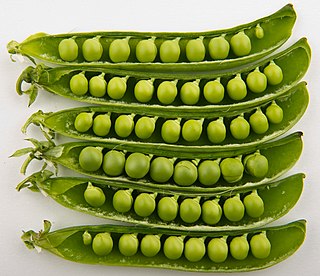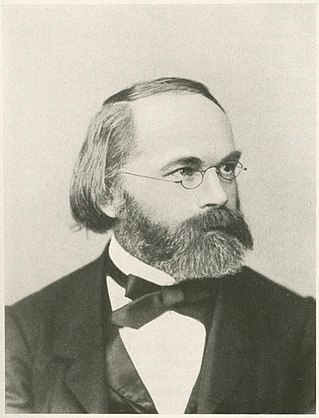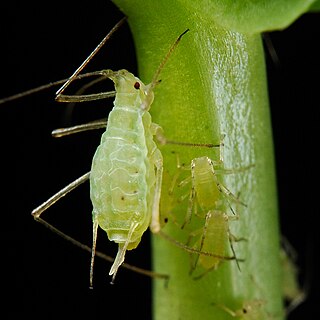Related Research Articles

Plant cells are the cells present in green plants, photosynthetic eukaryotes of the kingdom Plantae. Their distinctive features include primary cell walls containing cellulose, hemicelluloses and pectin, the presence of plastids with the capability to perform photosynthesis and store starch, a large vacuole that regulates turgor pressure, the absence of flagella or centrioles, except in the gametes, and a unique method of cell division involving the formation of a cell plate or phragmoplast that separates the new daughter cells.

The pea is most commonly the small spherical seed or the seed-pod of the flowering plant species Lathyrus oleraceus. Each pod contains several peas, which can be green or yellow. Botanically, pea pods are fruit, since they contain seeds and develop from the ovary of a (pea) flower. The name is also used to describe other edible seeds from the Fabaceae such as the pigeon pea, the cowpea, and the seeds from several species of Lathyrus.

Phloem is the living tissue in vascular plants that transports the soluble organic compounds made during photosynthesis and known as photosynthates, in particular the sugar sucrose, to the rest of the plant. This transport process is called translocation. In trees, the phloem is the innermost layer of the bark, hence the name, derived from the Ancient Greek word φλοιός (phloiós), meaning "bark". The term was introduced by Carl Nägeli in 1858.

Carl Wilhelm von Nägeli was a Swiss botanist. He studied cell division and pollination but became known as the man who discouraged Gregor Mendel from further work on genetics. He rejected natural selection as a mechanism of evolution, favouring orthogenesis driven by a supposed "inner perfecting principle".

A legume is a plant in the family Fabaceae, or the fruit or seed of such a plant. When used as a dry grain, the seed is also called a pulse. Legumes are grown agriculturally, primarily for human consumption, for livestock forage and silage, and as soil-enhancing green manure. Well-known legumes include beans, soybeans, chickpeas, peanuts, lentils, lupins, grass peas, mesquite, carob, tamarind, alfalfa, and clover. Legumes produce a botanically unique type of fruit – a simple dry fruit that develops from a simple carpel and usually dehisces on two sides.

Sap is a fluid transported in xylem cells or phloem sieve tube elements of a plant. These cells transport water and nutrients throughout the plant.
Nitrogen assimilation is the formation of organic nitrogen compounds like amino acids from inorganic nitrogen compounds present in the environment. Organisms like plants, fungi and certain bacteria that can fix nitrogen gas (N2) depend on the ability to assimilate nitrate or ammonia for their needs. Other organisms, like animals, depend entirely on organic nitrogen from their food.

Root nodules are found on the roots of plants, primarily legumes, that form a symbiosis with nitrogen-fixing bacteria. Under nitrogen-limiting conditions, capable plants form a symbiotic relationship with a host-specific strain of bacteria known as rhizobia. This process has evolved multiple times within the legumes, as well as in other species found within the Rosid clade. Legume crops include beans, peas, and soybeans.
The ascent of sap in the xylem tissue of plants is the upward movement of water and minerals from the root to the aerial parts of the plant. The conducting cells in xylem are typically non-living and include, in various groups of plants, vessel members and tracheids. Both of these cell types have thick, lignified secondary cell walls and are dead at maturity. Although several mechanisms have been proposed to explain how sap moves through the xylem, the cohesion-tension mechanism has the most support. Although cohesion-tension has received criticism due to the apparent existence of large negative pressures in some living plants, experimental and observational data favor this mechanism.
Transfer cells are specialized parenchyma cells that have an increased surface area, due to infoldings of the plasma membrane. They facilitate the transport of sugars from a sugar source, mainly mature leaves, to a sugar sink, often developing leaves or fruits. They are found in nectaries of flowers and some carnivorous plants. Transfer cells are specially found in plants in the region of absorption or secretion of nutrients.

The snow pea is an edible-pod pea with flat pods and thin pod walls. It is eaten whole, with both the seeds and the pod, while still unripened.
Reginald John Ellis is a British scientist.

Acyrthosiphon pisum, commonly known as the pea aphid, is a sap-sucking insect in the family Aphididae. It feeds on several species of legumes worldwide, including forage crops, such as pea, clover, alfalfa, and broad bean, and ranks among the aphid species of major agronomical importance. The pea aphid is a model organism for biological study whose genome has been sequenced and annotated.
John Albert Raven FRS FRSE is a British botanist, and emeritus professor at University of Dundee and the University of Technology Sydney. His primary research interests lie in the ecophysiology and biochemistry of marine and terrestrial primary producers such as plants and algae.
Giles Edward Dixon Oldroyd is a professor at the University of Cambridge, working on beneficial Legume symbioses in Medicago truncatula. He has been a Royal Society Wolfson Research Merit Award winner and the Society of Biology (SEB) President's Medal winner. From 2014 Giles has been in the top 1% of highly cited plant scientists across the world.

Paul Gordon Jarvis was a leading ecologist and Professor of Forestry and Natural Resources at the University of Edinburgh from 1975 to 2001.

Phloem loading is the process of loading carbon into the phloem for transport to different 'sinks' in a plant. Sinks include metabolism, growth, storage, and other processes or organs that need carbon solutes to persist. It can be a passive process, relying on a pressure gradient to generate diffusion of solutes through the symplast, or an active process, requiring energy to create membrane-bound transporter proteins that move solutes through the apoplast against a gradient. Passive phloem loading transports solutes freely through plasmodesma in the symplast of the minor veins of leaves. Active transport occurs apoplastically and does not use plasmodesmata. An intermediate type of loading exists that uses symplastic transport but utilizes a size-exclusion mechanism to ensure diffusion is a one-way process between the mesophyll and phloem cells. This process is referred to as polymer-trapping, in which simple solutes such as sucrose are synthesized into larger molecules such as stachyose or raffinose in intermediary cells. The larger molecules cannot diffuse back to the mesophyll but can move into the phloem's sieve cells. Therefore, the synthesis of larger compounds uses energy and is thus 'active' but this strategy does not require specialized proteins and can still move symplastically.
Plants can be exposed to many stress factors such as disease, temperature changes, herbivory, injury and more. Therefore, in order to respond or be ready for any kind of physiological state, they need to develop some sort of system for their survival in the moment and/or for the future. Plant communication encompasses communication using volatile organic compounds, electrical signaling, and common mycorrhizal networks between plants and a host of other organisms such as soil microbes, other plants, animals, insects, and fungi. Plants communicate through a host of volatile organic compounds (VOCs) that can be separated into four broad categories, each the product of distinct chemical pathways: fatty acid derivatives, phenylpropanoids/benzenoids, amino acid derivatives, and terpenoids. Due to the physical/chemical constraints most VOCs are of low molecular mass, are hydrophobic, and have high vapor pressures. The responses of organisms to plant emitted VOCs varies from attracting the predator of a specific herbivore to reduce mechanical damage inflicted on the plant to the induction of chemical defenses of a neighboring plant before it is being attacked. In addition, the host of VOCs emitted varies from plant to plant, where for example, the Venus Fly Trap can emit VOCs to specifically target and attract starved prey. While these VOCs typically lead to increased resistance to herbivory in neighboring plants, there is no clear benefit to the emitting plant in helping nearby plants. As such, whether neighboring plants have evolved the capability to "eavesdrop" or whether there is an unknown tradeoff occurring is subject to much scientific debate. As related to the aspect of meaning-making, the field is also identified as phytosemiotics.
Felix Dapare Dakora, is a Ghanaian plant biologist investigating biological nitrogen fixation at the Tshwane University of Technology in South Africa. He currently serves as President of The African Academy of Sciences for the 2017–2023 terms. Dakora was awarded the UNESCO-Equatorial Guinea International Prize for Research in the Life Sciences and the African Union Kwame Nkrumah Scientific Award. Dakora is a Fellow of the Academy of Science of South Africa.

William Brown was a British mycologist and plant pathologist, known for his ground-breaking research on fungal physiology and the physiology of plant parasitism by fungi, carried out in 1912–28. Born in rural Scotland and educated at the University of Edinburgh, he spent nearly all his career at the Imperial College of Science and Technology in London, where he created the plant pathology research school in the 1920s, becoming Britain's first professor of plant pathology in 1928, and heading the department of botany (1938–53). He was president of the Association of Applied Biologists and the British Mycological Society. He studied Botrytis cinerea, which causes grey mould in a variety of plants, and various Fusarium species that attack apples.
References
- 1 2 3 4 5 "Emeritus Professor John Pate". University of Western Australia. Retrieved 30 October 2023.
- 1 2 3 "Pate, John Stewart (1932 - ) FAA FRS". Encyclopaedia of Australian Science and Innovation. Retrieved 30 October 2023.
- 1 2 3 4 Turner, Neil (September 2023). "A life well lived: Vale Emeritus Professor John Pate" (PDF). Newsletter UWA Institute of Agriculture (50): 6. Retrieved 30 October 2023.
- 1 2 3 Devops, Diversus (15 December 2017). "Unravelling the extraordinary life of Professor John Pate". Particle:SciTech. Retrieved 30 October 2023.
- 1 2 "Professor John Pate FAA FRS". Australian Academy of Science. Retrieved 30 October 2023.
- ↑ "Academy Fellows celebrated with Order of Australia honours". Australian Academy of Science. Retrieved 30 October 2023.